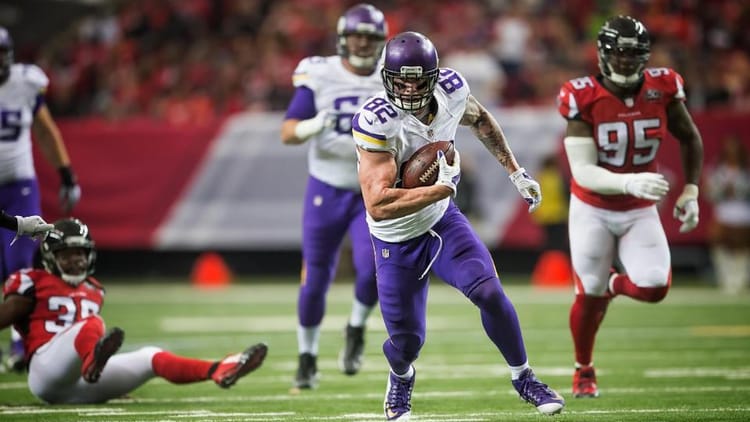Poll of the Week: The Seahawks Have a Tight End Problem

Mike Zimmer’s three-week bird hunting retreat continues, as the Minnesota Vikings (8-3) play host to the Seattle Seahawks (6-5) this Sunday at TCF Bank Stadium. After their convincing 20-10 victory over the Atlanta Falcons in Week 12, the Vikings will look to make a statement against the Seahawks, who fell just short of winning Super Bowl XLIX last February.
Despite their superior record, the Vikings are home underdogs to the suddenly-hot Seahawks. Pete Carrol’s football team has gone 4-1 since a disappointing 2-4 start and beat the Pittsburgh Steelers in a shootout last week behind Russel Wilson’s five touchdown passes. On defense, they rank in the top 10 in points allowed, yards allowed, passing defense and rushing defense. It’s the start of a difficult set of games for Minnesota, but it may be coming at the perfect time.
Why? The Seahawks have a legitimate problem in the secondary — containing tight ends. And Minnesota’s oft-injured tight end, Kyle Rudolph, is finally emerging as one of the Vikings’ most valuable receiving weapons. When the teams do meet Sunday, look for Rudolph to make an impact in the middle of the field.
Every coverage, from Cover-0 to Cover-6, has it’s weaknesses. In Cover-2, for example, two safeties are responsible for the deep area of the field. Each player splits the field in half and is expected to defend their own zone. The cornerbacks underneath typically defend the area of the field known as “curl-to-flat” while the linebackers drop to defend the “hook-to-curl.” At its most basic, the Cover-2 has two weak spots — in the middle of the field between the two deep defenders and in the void between the cornerbacks and the safeties.
The Seahawks employ a a few simple single-high looks, with safety Earl Thomas serving as the single-high safety in most coverages (Cover-1, Cover-3, Cover-6). Bucky Brooks of NFL.com broke down the defense last season and provided a concise explanation of Seattle’s strategy against the pass:
[quote_center]The hybrid Cover-3 puts cornerbacks in press coverage on the outside, with the four underneath defenders dropping to designated areas (numbers, hash, hash and numbers, etc.) at around 12 yards from the line of scrimmage. The underneath defenders are instructed to play with vision on the quarterback, to help them make quicker breaks on throws within their respective areas.[/quote_center]
This season, Seattle is blitzing just 22 percent of the time, a significant decrease from 28 percent in 2013. Their decision to keep more defenders in coverage hasn’t paid off, though. Before Sunday’s win over the Steelers, Seattle had allowed 57 pass plays of 15 yards or more, with eight of those plays going for at least 25 yards. The most damage has come in the area of the field between the dropping linebackers and the single-high safety — the softest spot in a Cover-3 defense.
In most offenses, tight ends rule the middle of the field. This is especially true in today’s NFL, where tight ends are faster than linebackers and bigger than safeties. Seattle, in particular, has struggled this season to match that size and speed. Fifteen of the pass plays for at least 15 yards given up by the Seahawks have been to tight ends, and tight ends have scored touchdowns in six games against Seattle. Below, a look at their deficiencies when covering tight ends:
That’s why Kyle Rudolph’s emergence couldn’t have come at a better time for the Vikings. He has 13 receptions in his past two games, his highest catch total in consecutive games in his NFL career, per the team’s official website. Against the Falcons, he caught seven passes (10 targets) for 53 yards, leading the Vikings in all three categories. On the year, his four touchdown catches are a team-high. That’s not saying much for the Vikings’ 32nd-ranked passing attack, but he’s proving to be a reliable option for second-year quarterback Teddy Bridgewater.
“It’s just great to get Kyle going,” Bridgewater said, per Vikings.com. “Especially coming off of last week’s performance. He’s a guy that’s a hard worker, detailed guy, and he is playing some good football for us right now.”
The previous week, Rudolph caught 6 passes for a career-high 106 yards against the Packers, scoring on a beautiful corner route in the first quarter and making a number of contested catches to keep the Vikings competitive late. Finally healthy, Rudolph’s beginning to silence those who questioned the team’s decision to reward the tight end with a five-year, $36.5 million contract extension last year. And on an offense that’s struggled to move the ball through the air, Rudolph has emerged as the team’s most consistent option.
He’s also an important cog in Minnesota’s league-leading rushing attack. Per Pro Football Focus, Rudolph has been used on more than half (50.7 percent) of his snaps as a run or pass blocker. That balanced skill-set will prove critical to the Vikings’ success against the Seahawks this week, and Zimmer applauded Rudolph for his versatility and commitment on Monday:
[quote_center]”Kyle is a very conscientious kid. Obviously he’s kind of a receiver at heart, he wants to catch the ball like everybody does, he’s kind of bought in to the concept as well about, ‘This is who we are, and I don’t know when my opportunity is going to come, but when it does, I have to take advantage of it.'”[/quote_center]
Seattle remains one of the league’s best defensive teams, but Minnesota has the weapons in Kyle Rudolph, Rhett Ellison (if you consider a bulldozer a weapon), and MyCole Pruitt to attack them where they’re weakest — the middle of the field. Can Teddy Bridgewater take advantage and exploit the Seahawks’ fragile Cover-3? Take the poll below and share your thoughts in the comments section!

You must be logged in to post a comment.